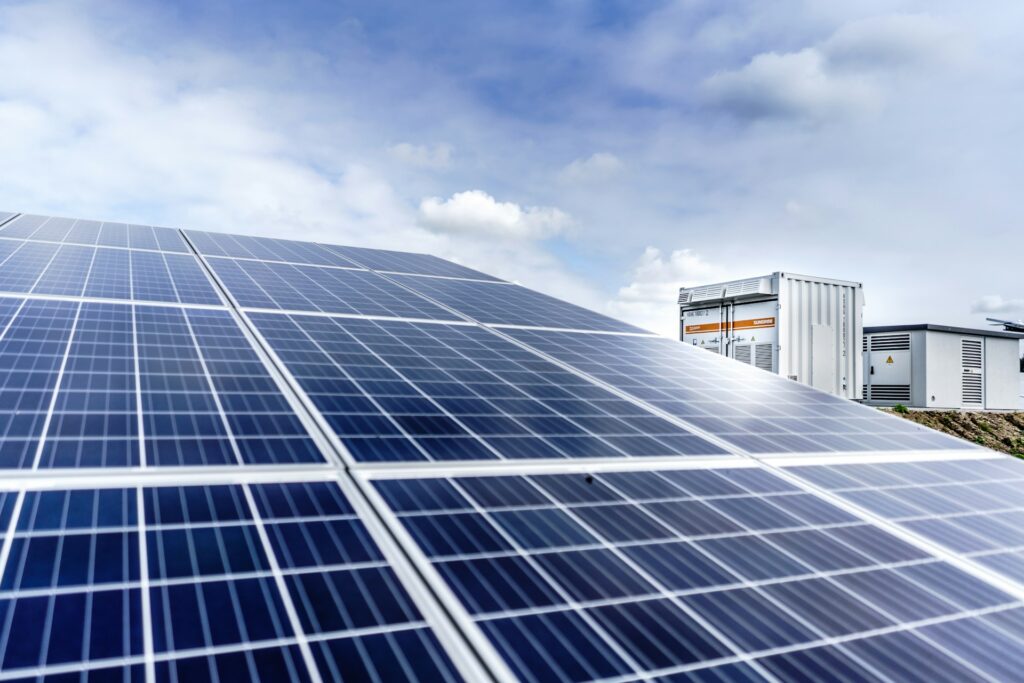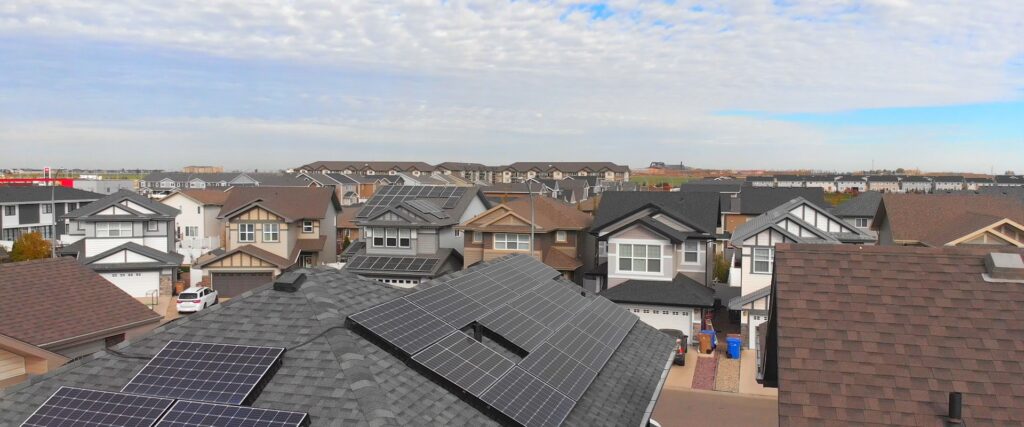The fundamental difference between commercial and residential solar panels lies in size, scale, and application. Residential solar systems provide electricity for houses (usually 5–20 kW), on the other hand, commercial panels are large, more efficient, and serve companies or facilities (50 kW–1 MW+). Commercial size solar panels offer better economies of scale and make use of corporate tax incentives, while residential systems offer faster installation and less difficult approval.
As the cost of power keeps rising, more homeowners and business owners are turning to solar energy as a reliable, sustainable option. However, a rooftop solar system for domestic use is completely different from one for a large commercial facility. Understanding these differences is important to making the right investment decision.
This guide breaks down the key differences between industrial and residential solar panels, the specific benefits of each, and how to determine the high-quality solar system for your property and budget.
Table of Contents |
|
|
|
|
|
|
Residential vs. Commercial Solar Panels: A Quick Overview
While each residential and commercial structure utilises photovoltaic (PV) technology to transform daylight into energy, their design, scale, and economic systems are worlds apart.
Residential Systems
Residential solar systems are designed to fulfill the energy needs of a single-family home.
- System Size: Typically small, starting from 3 to 5 kilowatts.
- Focus: Reducing or Eliminating monthly electricity bill of a house, reducing carbon footprint, and increasing property value.
- Installation: Installed on slanted rooftops, usually using a mounting system that fits to the roofline.
Commercial Systems
Commercial solar systems are built for the heavy, centralized energy needs of companies, schools, government buildings, and industrial facilities.
- System Size: Large scale, starting around 50 kW and often exceeding 1 MW (megawatt).
- Focus: Achieving large-scale operational savings, getting big corporate tax breaks, and reaching sustainability goals.
- Installation: Usually put on huge, flat rooftops (often using ballasted, non-penetrating racks) or as ground-mounted systems in open land.
Key Differences Between Residential and Commercial Solar Panels
The term “commercial vs residential solar panels” encompasses more than simply the property type. The variations affect panel specifications, price structure, and the whole installation process.
1.Scale and System Size
The most obvious difference is the size and electricity generation.
-
Residential Panels:
Generally use smaller panels (60 or 72 cells), which are simpler for one or two people to handle and fit successfully onto the limited and often complicated surface of a residential roof. System capacity does not often exceed 20 kW.
-
Commercial Panels:
Use larger, more effective panels (often 72 cells or more) with a higher wattage output (e.g., 450W to 600W). The systems need to generate a high extent of power to help non-stop commercial operations, resulting in system sizes 10 to a 100 times larger than an average residential system.
2.Panel Technology and Equipment
While both use silicon PV cells, the supporting components vary significantly.
-
Residential:
Often utilize micro-inverters or string inverters with electricity optimizers. The goal is to maximise electricity generation and control shading on complex, sectioned roof areas. The device is generally tied to a single-phase power grid.
-
Commercial:
Systems depend upon massive, centralized string inverters or commercial-grade micro-inverters capable of handling high voltage and 3-phase power, which are generally for industrial buildings. The emphasis is on typical system efficiency and strong, long-term performance.
3.Cost and Financial Considerations
The approach to cost and return on investment (ROI) is a primary distinguishing factor,
| Financial Metric | Residential Solar | Commercial Solar |
| Cost Per Watt | Higher (Avg. $\$2.70 – \$3.15$ per watt) | Lower (Avg. $\$1.83$ per watt) |
| Why? | Higher labor costs relative to scale, complex installation. | Economies of Scale: Bulk purchasing of equipment, large-volume installation reduces cost per watt. |
| Primary Incentive | Federal Investment Tax Credit (ITC) for homeowners. | Federal ITC, accelerated depreciation (MACRS), and corporate tax deductions. |
| Average Payback Period | $8 – 10$ years | $4 – 7$ years |
Commercial systems have a higher upfront cost but benefit greatly from economies of scale, making the cost per watt notably lower than residential systems.
4.Installation and Permitting
-
Residential Installation:
Typically takes 1 to a few days to install panels, with a total project timeline of 1 to 3 months (along with permitting and application connection). Usually, getting a permit is easier and faster.
-
Commercial Installation:
It can take weeks or even months because there are so many panels. The whole project, from design to engineering to complicated utility interconnection agreements, can take 6 to 12 months. There are a lot more strict rules about safety, fire codes, and structural engineering.
5.Lifespan and Maintenance
-
Residential:
Panels typically come with a 25 years overall performance warranty. Maintenance is minimal, usually monitoring and occasional cleaning.
-
Commercial:
While business panels have a 25-year overall performance warranty, they’re designed for heavy-duty environments and often require greater daily, scheduled maintenance and monitoring to ensure maximum uptime, as electricity loss directly influences running cost.
Benefits of Each System
Both solar applications supply powerful benefits, but they’re tailored to distinctive needs.
Residential Solar Panels:
-Reduce monthly electricity bills.
-Homes with solar panels often sell faster and at a higher rate.
-Access to the Federal ITC and local rebates designed for homeowners.
-Faster installation and running timeline.
Commercial Solar Panels:
-Large-scale energy savings and carbon footprint reduction. Substantially reduce operating expenses for electricity-intensive businesses.
-Access to valuable corporate tax deductions and accelerated depreciation schedules.
-Improved brand sustainability image. Demonstrates a dedication to environmental responsibility, often favored by means of current clients and stakeholders.
-Better economies of scale. Lower cost per watt makes the overall long-term investment more profitable.
Which Solar Type Is Right for You?
The decision between residential and commercial solar comes down to the nature of your property and your long-term energy needs.
Choose Residential Solar If:
-You need electricity independence at home and protection against rising utility charges.
-Your roof or property supports a limited number of panels (commonly below 20 kW).
-You select a smaller investment with a faster, easier setup procedure.
Choose Commercial Solar If:
-You manage a business, school, or facility with excessive, constant electricity utilization.
-You have a large, unshaded roof space or access to open land for floor mounting.
-You need to maximize ROI by taking advantage of corporate financial and tax incentives.
Conclusion
The preference between commercial and residential solar panels is described by property type, electricity needs, and the precise monetary incentives available to you. While residential solar gives owners a quick route to electricity savings and elevated property prices, commercial solar gives organizations with powerful economies of scale and sizable, long-term ROI.
Ultimately, both programs are powerful tools for achieving both environmental and financial goals when designed and set up efficiently. Knowing the main differences from panel size and cost structure to installation complexity, you can optimistically pursue a solar solution that is perfectly aligned with your goals.
Ready to power your property with clean power? Contact us at RAR Energy and get a free solar consultation today to compare residential and commercial solar panel options that fit your power dreams and budget.
Frequently Asked Questions (FAQ)
Q: What is the difference between commercial and residential solar panels?
The main difference lies in size, performance, and efficiency. Residential solar panels power houses (normally 5 kW–20 kW system). Commercial panels serve companies or large buildings (50 kW–1 MW+). Commercial systems are larger, utilize higher-wattage panels, and are often mounted on flat roofs or open spaces for maximum energy output.
Q: Are commercial solar panels worth it?
Yes, commercial-sized solar panels offer a strong long-term ROI and large-scale financial savings. They help companies in cutting massive operating expenses, qualify for big tax credits and incentives (like increased depreciation), and achieve sustainability goals. Although upfront costs are higher, most systems see a payback length of 4 to 7 years and continue to generate free energy for decades thereafter.
Q: Why is my electric bill so high when I have solar panels?
A high electricity bill with solar panels normally means your system isn’t covering 100% of your overall usage. Common reasons include higher energy intake than expected (e.g., buying an electric-powered car or a brand new AC unit), seasonal modifications decreasing sunlight, or physical issues like dirty or shaded panels. Monitoring your system and scheduling maintenance can quickly diagnose and fix most problems.
Q: What is the 33% rule in solar panels?
The 33% rule suggests that a solar system must be sized to provide roughly 1/3 more electricity than your overall historical energy consumption to effectively offset system inefficiencies. For instance, if your common daily consumption is 10 kWh, you should aim for a system that generates approximately 13-14 kWh every day to ensure steady coverage and high overall performance throughout the year.





